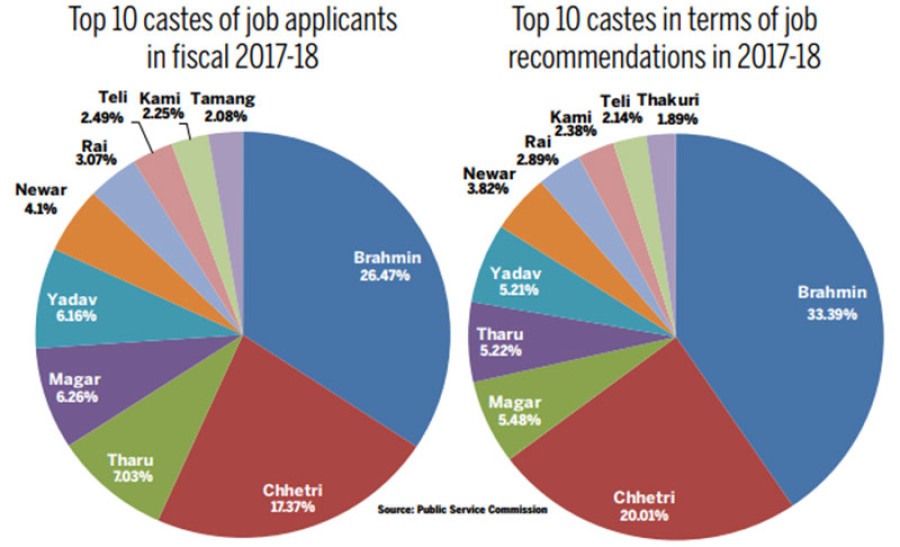Miscellaneous
Brahmins and Chhetris land most government jobs
Brahmins and Chhetris, two dominant classes in Nepali society, continue to lead in terms of landing civil service jobs despite an inclusive hiring policy reserving quotas for Janajatis, Dalits and other disadvantaged groups.
Prithvi Man Shrestha
Brahmins and Chhetris, two dominant classes in Nepali society, continue to lead in terms of landing civil service jobs despite an inclusive hiring policy reserving quotas for Janajatis, Dalits and other disadvantaged groups.
According to the Public Service Commission (PSC), the two castes constituted over 50 percent of the candidates recommended by the PSC for government jobs in the fiscal year 2017-18.
The PSC annual report for 2017-18 shows that Brahmins secured 33.39 percent of total government jobs, followed by a 20.01 percent share of the Chhetris, from among the 7,718 candidates recommended for civil service positions.
In proportion to the population, the percentage of jobs claimed by the two communities is higher. According to the 2011 census, Chhetris account for 16.6 percent of the total population, followed by Hill Brahmins (12.2 percent). In the Tarai, Brahmins constitute 0.5 percent of the total population, according to the Central Bureau of Statistics.
“Brahmins and Chhetris are the two communities conventionally focused on government jobs,” said PSC Chairman Umesh Mainali. “So it’s natural that they continue to lead in the number of government jobs as well as applying for them.”
The percentage of fresh recruits in civil service was more than 40 in the fiscal year 2016-17. According to the PSC, 22.96 percent new jobs went to Brahmins and 18.67 percent to Chhetris that year.Massive applications from these two communities also raise their chance for selection in civil service even as the Civil Service Act reserves 45 percent seats for women, indigenous groups, Madhesis, Dalits, people with disability and those from the backward regions. Open competition is held only for 55 percent seats.Forty-four percent of applicants came from the two castes last fiscal year. According to the commission, of the 567,853 total applicants, 26.47 percent were Brahmins and 17.37 percent Chhetris.
Indigenous rights activists say that since the country adopted the inclusion policy in 2007, entry of ethnic groups into civil service has been rising.
“But the presence of indigenous communities is still not in proportion to their population. This requires continuation of the existing policy,” said Ganesh Lal Thakali, vice-chairperson of the Nepal Federation of Indigenous Nationalities.
Indigenous rights advocates fear that provisions of the proposed Federal Civil Service Bill could curb growing representation of indigenous groups in government service as Brahmins and Chhetris have also been made part of the representation policy. The bill proposes 12 percent seats for poor Khas-Arya members while quotas are allocated also for the Tharus, Muslims and backward communities. The Civil Service Act treats Tharus as Madhesis. “We want a continuation of the existing policy,” said Thakali.




 10.12°C Kathmandu
10.12°C Kathmandu








%20(1).jpg&w=300&height=200)

